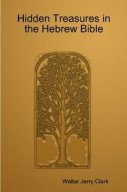It's Greek to Me!
Word studies in the New Testment based on the original Greek text. The book includes an overview of the Greek language, along with 53 chapters which investigate over 100 important words and terms.
by Walter Jerry Clark
soft cover, 171 pages, 6" x 9"
To order using credit card or PayPal:
IT's GREEK TO ME!
For More Information:
SOPHRONISMICS BOOKSTORE
Excerpt...
Agape, koinonia, ekklesia, charisma, apokalupsis, koine . . . . You may have noticed that words such as these are popping up more and more frequently in Bible studies, Sunday school lesson quarterlies, and your pastor's sermons. Where are these new words coming from? Why are such unusual-sounding words used?
Actually, words such as these are not new at all. They are as old as the church itself, for they are words from the New Testament in the language of the original Greek. The use of such words by writers, speakers. and ministers, however, often leaves laymen confused. Just what is New Testament Greek, anyway? Why is there such great interest in a two-thousand-year-old language?
New Testament Greek is the language of the original New Testament writings. This Greek, however, differs considerably from classical Greek. For centuries after the Renaissance rediscovery of the great Greek writers. poets. and playwrights, Bible scholars recognized and puzzled over these differences. Giving the matter considerable thought and study, most scholars finally came to the conclusion that the Greek of the New Testament was a special language used only for religious purposes. Some even went so far as to suggest that the language was a "holy" language which found its origin in the direct dictation of the Holy Spirit.
This conclusion was not to go unchallenged for long, however. One day, around the beginning of this century, a young German pastor named Adolf Deissmann happened to be leafing through a new volume of manuscripts from a collection of ancient Greek documents written on papyrus. Deissmann, as he read, was suddenly struck by the similarity of the language of these papyri to the language of the Greek New Testament.
"The papyri" is a general name for the thousands of writings which have been discovered from the early Christian and pre-Christian era. At this time the Greek language was the "lingua franca" or international language of the Roman Empire. These writings are known as papyri because they were written on papyrus, a writing material made from the pith of a reed once common along the Nile River.
These are the writings of common persons. They are household papers, business records, contracts, personal letters, commercial notes, and so forth. They are not literary works or scholarly works but the "common" writings of persons engaged in the day-to-day business of living. On the outskirts of old Egyptian towns and villages, these papers were discarded and heaped, sometimes to a height of twenty to thirty feet. Probably out of reverence for the written word, no matter how banal or useless, these papers were not burned but simply discarded (much to our advantage today).
These heaps of papyri were quickly covered by the shifting desert sands and thus remained almost perfectly preserved down to the present era. About ten thousand of these early documents have now been published, and the number is constantly growing.
Deissmann,the young German pastor, recognized that the Greek of the New Testament was almost identical to the Greek of these papyri. The New Testament, he boldly announced, was not written in a special "holy" language at all, but in the tongue of the common people. This language has come to be known as koine Greek, from the Greek word for common (meaning held in common by the masses, not necessarily low or substandard).




